
by John P. Pratt (29 Feb 2016)
13 Skull (SR), 0 Creation (UV, M, UM), 0 Adult (UMa)
©2016 by John P. Pratt. All rights Reserved.
| 1. Leap Year |
| 2. Best Year Length? |
| 3. Designed Year Length |
| 3.1 Enoch Calendar |
| 3.2 Hebrew Calendar |
| 3.3 Day-Year Pattern |
| 3.4 Planetary Calendars |
| 4. Conclusion |
| Notes |
If you were God and you were creating our solar system to be used to keep time, how long would you make the year? Would it be a nice, even number like 360 days? Or would it be some weird number like 365.2425 days? For some reason God chose the latter, at least as an average length for the 7,000 years after Adam. The length of our solar year is slowly decreasing, with the current value being 365.2422 days. It is because the time of the earth to orbit the sun is not an exact number of days that we insert an extra leap day nearly every four years, just as we are doing today (29 Feb), to compensate for the .2422 fraction of a day. This article shows that our precise year length is not an example of God's sloppiness, but instead it is actually a witness of the Creator's superior intelligence when He designed our solar system to be a huge clock.
 |
The ancient Egyptians used a year of exactly 365 days. They never inserted any extra days. Isn't that close enough to 365.2425 to be okay? Well, it's close enough to know for a few years when the Nile was going to overflow, which was an integral part of the Egyptian planting and harvesting annual cycle. But because their year was about a quarter day short, after only a hundred years their calendar would be nearly a whole month off. It turns out they were well aware of this and they just used that calendar anyway for other reasons. After 1,461 years their calendar would cycle through all of the seasons back to its starting point.
Lehi lived in a world closely tied to Egypt. Although he used the Hebrew Calendar for sacred rituals, it seems clear that he used the Egyptian Calendar for civil years. When the Nephites were counting 600 years from the day on which Lehi left Jerusalem until the coming of Christ (1 Nephi 10:4), they were almost certainly using years of exactly 365 days, as did the Mayans and Aztecs. Because their calendar was off by about a quarter day every year, after 600 years it was off by .25 x 600 = 150 days, or about 5 months. Thus they believed that the 600 years had expired about 5 months before the Savior would be born. This explains the great confusion about exactly when the sign of Christ's birth would be given as described in 3 Nephi 1.[1]
Julius Caesar decided to correct the Roman calendar by adding one extra day every four years. That is, it wouldn't do to add a quarter day every year or else one year would start at midnight and the next at 6 a.m. and the next at noon, etc. So to have each day start at midnight, his astronomer Sosigenes told him to add one full day every four years. That is, three years of 365 days and one of 366 will average exactly 365.25 days in length. Before that new calendar started, called the Julian Calendar in his honor, the first month of the year had been March, so the extra day came at the end of February, the last month of the year.[2] (Actually, it took a while for this all to really happen correctly, but that's the idea.) Even though Caesar began using the new calendar in 45 BC, it turns out that the years which are leap years are easy to calculate using the Christian era (AD) because the AD pattern began with the year 1 and if a subsequent year is exactly divisible by 4 then it is always a leap year on the Julian Calendar. Thus, 2016 (= 4 x 504) is a leap year.
The Julian Calendar was used throughout Europe from 45 BC to AD 1582. At that time Pope Gregory XIII noticed that Easter was coming ten days later than it should have. That was because of the tiny discrepancy between the 365.2500 days of the Julian Calendar and the true year of 365.2425 days. His astronomer told him it could be corrected by skipping ten days and thereafter skipping the leap day on three century years out of four. Thus 1700, 1800 and 1900 were not leap years, but 2000 was. That corrected calendar is called the Gregorian Calendar in the Pope's honor. At first it was adopted only in Catholic countries, but now is used world wide. This calendar is used almost exclusively in my work as the civil calendar by projecting it backwards to long before it was used, all the way to Adam. It is accurate to within one day for all 7,000 years after Adam.
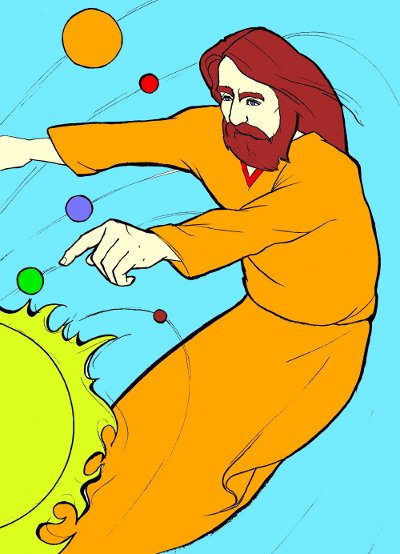 |
As the earth revolves around the sun every year, the sun seems to move slowly against the background of stars (even though it is so bright you can't see them). Through what angle does it move every day? Well, if the length of the year were 360 days, and if it made a full revolution of 360 degrees every year, then it would move through exactly 1 degree every day. Many believe that this is the origin in ancient Babylon of our system of diving a circle into 360 degrees. They wanted a number that was approximately equal to the length of the year but which was really useful to easily divide into exactly equal parts.
So was God as smart as the ancient Babylonians? Why didn't He think of that? Or did He have an even better idea?
Let's look at other possibilities. One of God's sacred numbers, especially for time keeping is 7. The 7-day week is a fundamental unit of time. Another is 13, which is not as well known. Neither 7 nor 13 divides evenly into 360. On the other hand, both 7 and 13 divide evenly into 364, because 4 x 7 x 13 = 364. If the year were 364 days long then it could contain exactly 13 months of 28 days, each of which would be exactly 4 weeks. 364 is close to the true length of the year and indeed several sacred calendars have years of 364 days. Those calendars, such as the Enoch Calendar and Jubilee Calendar, add an entire leap week of seven days about every five years to keep those calendars in sync with the seasons. The Enoch Calendar has the advantage that every regular year has four quarters of 91 days each and every quarter begins on a Sunday.
Now let's look at some of the advantages of having a year of 365.2425 days rather than 360 or 364.
Let us now turn to reviewing evidence from my earlier articles that 365.2425 is not a random number, but one that was carefully chosen by a Designer. These arguments all are based on statistical evidence which conclude that it is just too hard to believe that so many wonderful coincidences could happen by chance. In fact statistical evidence is the basis of discovering many dates in my Religious Chronology.
It is unfortunate that probability and statistics are so abused and also so poorly understood, meaning that in many cases almost nothing can be proven to the layman using statistics. Even professionals can get confused. When someone asked Marilyn vos Savant (IQ 190) about the probability of winning in a quiz show, she gave a very simple and correct answer in her "Ask Marilyn" column in Parade Magazine. Many math professors from all over the country raked her over the coals for being wrong until she published a very simple diagram proving she was right.[3]
Ignorance and skepticism of probability arguments may keep my work from being accepted, but to me the probability arguments truly appear as compelling evidence that what has been discovered in my work is actually true and will stand the test of time. Many statisticians make their living by using probability, such as insurance companies using life expectancy tables to calculate the probability of a person dying at any given age. Probability calculations work well to describe the real world and are mathematically defined.
One more important point is that in the modern secular world, most people have been so conditioned not to see God that He is no longer recognized by His creatures (creations). If you do not see God in every flower, butterfly and hummingbird, then you may not see His hand as the Great Watchmaker of the Heavenly Clock in what follows. Thus this article cannot prove there is a Creator, but can only offer evidence that there is virtually no chance that the arguments which follow all just happened by chance.
With that disclaimer, let us now turn to some of the amazing coincidences which testify of the hand of a Creator.
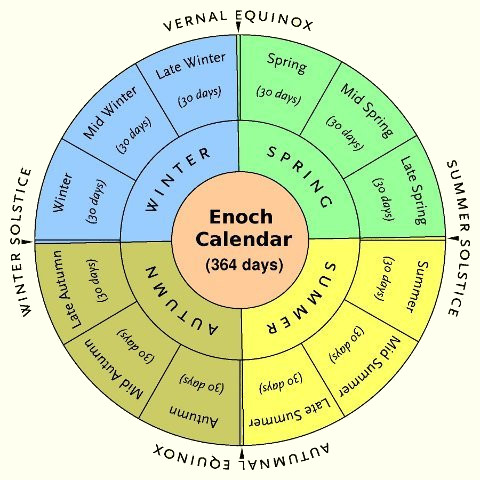 |
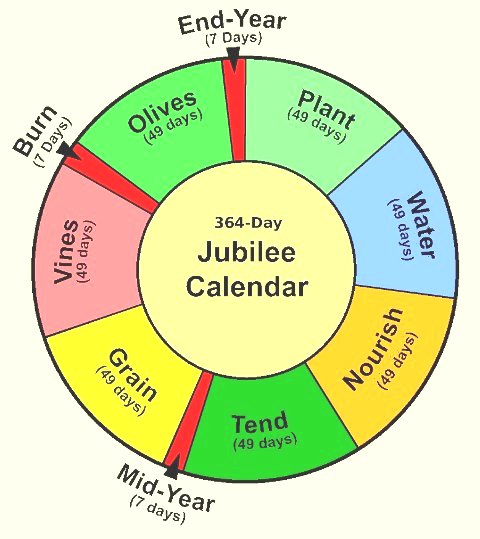 |
On many of the most sacred days in history, however, several of these sacred calendars all aligned to be on various holy days on each calendar. For example, both of the days of the Savior's baptism and transfiguration occurred on the Feast of Tabernacles on the Enoch Calendar and also on the Great Last Day of the Feast of Tabernacles on the Jubilee Calendar. Such an alignment is rare, but it occurred on both of those sacred days in history. Keep in mind that each of these calendars has an entirely different way to insert the extra week when needed, so these alignments depend on the exact length of the solar year.
One of the most important sacred calendars, along with that of Enoch, is the Hebrew Calendar. Each of them has a year which averages about 365.2425 days in the long term, but they are totally different in most respects. The Enoch calendar aligns with 1) the week, 2) the year, and 3) the lunar month (29.53059 days) in that order of importance. The first day of the year is always on a Sunday on or after the first day of spring (spring equinox, 20-21 March). The extra week is inserted when it would best help the year also align with the lunar cycle. The year lengths are either 364 or 364+7=371 days.
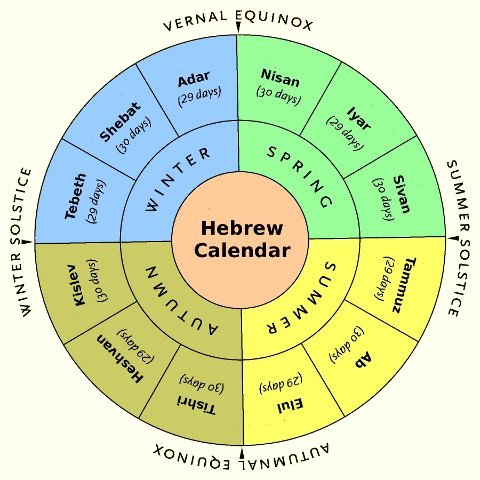 |
Thus it is clear that these are very different year lengths governed by very different principles including not only the precise length of the year but also of the lunar month. The Lord seems to love great variety in some creations like these various years and to love simple consistency in others like the unchanging 7-day week.
The witness that the year length has been been planned is that on the key sacred days of history, such as in the life of Jesus Christ or the birthdays of the great patriarchs, these calendars align to have those special days be holy days on both of these calendars at once. For example, all of the sacred calendars have a holy day to celebrate the Resurrection (Easter). On the actual day of Christ's resurrection, which was the most holy day of any in the 7,000 years since Adam, the day was Easter not only on both the Enoch and Hebrew Calendars but also on six other sacred calendars. That is, it was not just any holy day, but the very holy day representing the Resurrection on eight different sacred calendars! It was also another holy day on five other sacred calendars, making it the most holy day in all of history, being sacred on 13 of the 14 sacred calendars known to me so far.[6]
While the Resurrection date is an extreme case of sacred calendar alignments, there are hundreds of examples in my Religious Chronology. For example, the day on which Jesus began his public ministry on Sat 6 Apr 30 was Passover on both the Hebrew and Enoch calendars. The day on which Moses was transfigured was the Feast of Tabernacles on both the Hebrew and Enoch calendars. The day on which Josiah read the law of Moses was also the Feast of Tabernacles on both the Hebrew and Enoch calendars. And an example from the Book of Mormon is that the day on which Lehi left Jerusalem was Passover on both the Hebrew and Enoch calendars, exactly 600 years before the Hebrew Passover at the birth of Christ. All of these alignments depend on the exact lengths of the year as reckoned by calendars with totally different approximate year lengths. There are far too many of these alignments to be explained by random chance.
Another area where the exact length of the solar year is shown to have been planned is in how the Lord reckons years in the same pattern with which He counts days. This "day-year pattern", as it is called in my articles, provides one of the strongest witnesses that the length of the solar year was carefully chosen.
The most widely known example of the day-year pattern is that even as God counts weeks of 7 days, He also counts years by sevens in what are called "weeks of years". Thus every set of seven years can be thought of as beginning on a SUNDAY year, followed by a MONDAY year, and ending with a SATURDAY year. The SATURDAY years are sacred on the Hebrew Calendar, called the sabbath years, even as Saturday is the Hebrew sabbath day. The Hebrews are well aware of this day-year correlation. They have faithfully reckoned sabbath years ever since their return from the Babylonian exile, which had resulted in part from their having neglected to celebrate sabbath years (2 Chron. 36:20-21). This year 2016 is a SUNDAY year (in my work the names for years are capitalized to indicate they are years, not days).
Each of the sacred calendars which are based on the week have "Great Years" which follow the same pattern of the usual years. The Great Year on the Enoch and Jubilee calendars consists of sets of 364 years. No leap years are added to Great Years because they are not tracking a celestial body but only counting years. Each year in a Great Year corresponds to one day of the year on the pattern of that calendar. Thus there are "holy years" which correspond to the annual holy days. For example, there are years which are PASSOVER years or EASTER years.
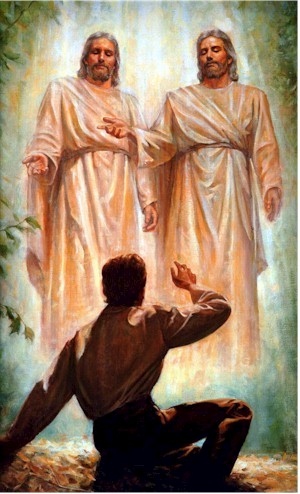 |
Of course, the very first day of the NEW YEAR'S DAY year of 1820 on the Enoch Calendar would be New Year's Day in the year NEW YEAR'S DAY. That holy day in the corresponding holy year occurred on Sun 26 Mar 1820. Remember, the Enoch year usually begins on the Sunday on or after the spring equinox (20 or 21 March). It was because of that day being doubly holy and representing the beginning day of a new era that it was proposed in my work as the day of the First Vision.[7] Later work by John Lefgren verified that day as a "a beautiful, clear day, early in the spring" (JSH 1:14) that was also surprisingly warm for that early in the year.[8] Moreover, another verification was discovered several years later that the day Sun 26 Mar 1820 also began the ninth of ten 728-year periods of the 7,280-year history prophesied in the Book of Enoch.[9] In other words, several years after Sun 26 Mar 1820 was proposed in my work as the date of the First Vision it was discovered that it "just happened" also to be the one day in over 700 years which began one of the periods of a prophecy in the Book of Enoch. To me that could not have happened by chance because I know I did not force that to work out that way. The beginning of the first period was found and then the rest were just calculated by adding the exact same number of days of each period. It was astonishing to me to see that my date for the First Vision began the ninth period.
Thus it becomes clear that the Lord is using extreme precision in all of this sacred symbolic reckoning and that the precise length of the solar year is extremely critical to make all of this work out to the very day.
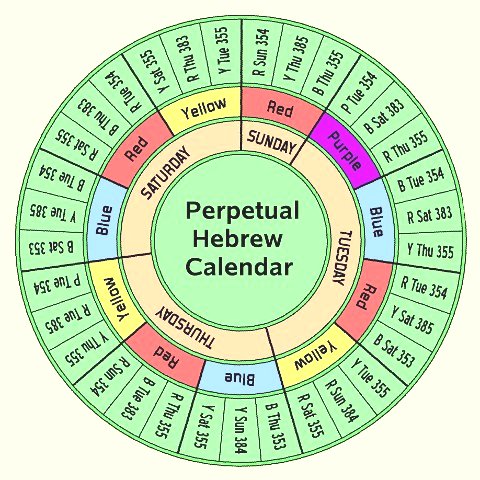 |
With that in mind, Great Years on the PHC use the day-year pattern applied to the same PHC Year Wheel shown in Figure 4 to group years into Great Years in the same manner as days are grouped into years. It also fits the weeks of years in the same way that the PHC fits the usual week of days. In an earlier paper it was shown how amazing this day-year correlation is.[11] Keep in mind that once a certain year is chosen to match the day-year pattern, every year in history is then fixed by following this wheel. There is no room for adjusting things so that things turn out as desired because this is the same wheel used to determine every Hebrew year.
Here some examples of years of key religious events in history, all of which are derived by using that same pattern of the PHC shown in Figure 4 (references can be found on my Religious Chronology):
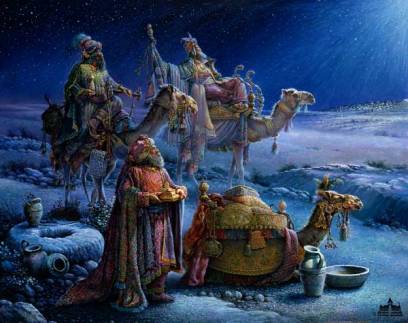 |
So far this discussion has just been about evidence that the precise length of our solar year was carefully designed. Now let us see how the length of the year also fits into the periods of other planets in the solar system, much like a precisely made gear meshes with other gears of other sizes.
 |
 |
Many more examples could be given to show how the precision increases and also the symbolism becomes clearer with longer periods. Let's consider just one more example. The length of the Venus Cycle is even better approximated by noting that 12 Venus cycles equals almost exactly 7,007 days = 7 Days of 1,001 days, = 77 trecenas = 143 weeks. 7,007 divided by 12 yields 583.92 days each for the Venus Cycle, which is correct to a hundredth of a day. Moreover, that divides time of 7,007 days into both 12 periods and 7 periods, both sacred division numbers. Thus the precise length of the Venus cycle strongly indicates design with deep symbolic meaning with the day-year pattern of 1,001 days representing 1,001 years.
The reason leap days are inserted into our year about every four years is to correct for the fact that the year is not 365 days but actually averages 365.2425 days. Evidence has been reviewed that the precise average length of our solar year is not just a random number, but was carefully designed by a Creator. The first evidence presented was just from sacred versions of our solar calendar such as the Enoch and Jubilee calendars. The way that key religious events tend to happen on their holy days throughout history provides evidence of design. Then it was shown that the Hebrew Calendar, based primarily on the moon causing it to have years of either about 354 or 384 days, also has years which add to the witnesses of design. Then evidence from the day-year pattern was reviewed showing how years are named the same as days and that sacred events tend to occur in sacred years symbolizing those very events much more than could expected from random chance. And finally, the solar year is like just one gear in an intricate and super-precise heavenly clock along with other gears of the other planetary periods, where each tooth on the gear represents exactly 13 days, the basic interval of the Sacred Round.
Taken all together, these arguments provide compelling evidence that the precise length of the year is not just a random and meaningless number, but instead was carefully designed for very accurate time keeping by a super-intelligent Creator.